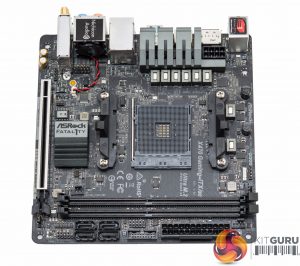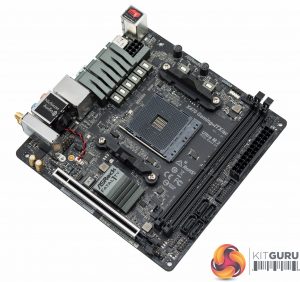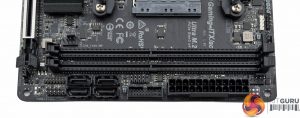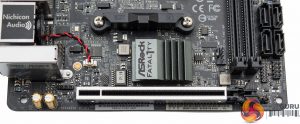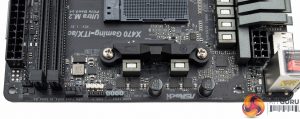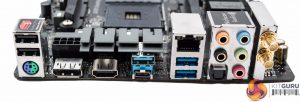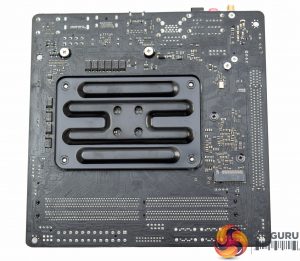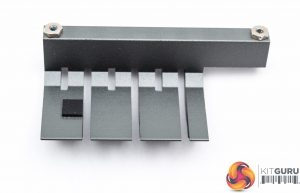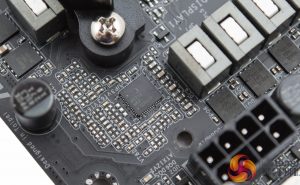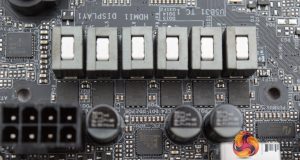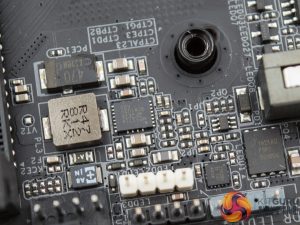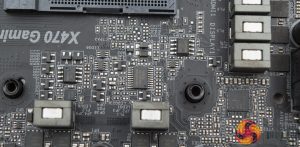The scope for stylistic touches on mini-ITX motherboards is fairly limited given the space constraints, particularly so on the AM4 socket compared to Intel LGA1151 where the AM4 mounting brackets consume additional space. ASRock implements only two compact heatsinks for the CPU VRM and chipset, both of a grey colour, in what is otherwise a neutral design.
Unlike some larger motherboards there are no onboard RGB LEDs but ASRock does provide two RGB headers of type 5v digital addressable and a 12v G R B (marked as AMD FAN LED), to add extra RGB strips or lighting.
ASRock provides four of six of the SATA III ports available with the X470 chipset, due to space constraints, along with a two USB headers of type 2.0 and 3.0. The single PCIe 3.0 X16 slot is reinforced for enhanced durability and just above that sits a fan header (CHA_FAN1/WP) which can supply up to 2 amps (24 watts) for water pumps.
The audio section uses an unshielded Realtek ALC1220 codec with no effective PCB separation. There are two Nichicon Fine Gold Series audio capacitors in use and we couldn't identify any additional amplifiers other than what is already integrated into the codec. This audio solution reflects the space constraints ASRock has to work within but should still offer strong performance courtesy of the high-grade codec.
At the top of the motherboard are the two RGB headers – 12v G R B (white) and 5v addressable (grey) along with two fan headers – CPU_FAN1 and CHA_FAN2, both supplying 1 Amp/12 watts.
The rear I/O provides 2 USB 2.0, two USB 3.0, and two USB 3.1 (Type-A and -C) as well as DisplayPort 1.2, HDMI 2.0, a full complement of audio connections and the WiFi antenna mounting points. The previous model (X370) had dual HDMI so the addition of DisplayPort provides some more graphical flexibility when used with APUs.
Underneath the motherboard is the primary M.2 connector supporting up to 2280 (80mm) devices in either SATA III 6Gbps or PCIe 32Gbps modes, there is no M.2 cooling solution provided. All screws in use are standard cross-heads for easy removal.
The CPU heatsink is very compact and our sample was missing a thermal pad. ASRock confirmed this was an error and that all retail samples do ship with a thermal pad between this heatsink and the MOSFETs. The heatsink directly covers the phases that supply the CPU voltage.
The controller is the Renesas (Intersil) ISL95712 controller which outputs up to 4+3 phases, CPU and SOC respectively. In this context the only plausible configuration is 3+2 phases (CPU + SOC) meaning that the CPU phases use two MOSFETs and two inductors per phase.
There are no doublers in use and doubler usage isn't possible as the ISL95712 integrates drivers for phases 1 and 2 of the CPU core and phase 1 of the SOC, with ASRock supplying a separate driver (likely ISL6625As) for the third CPU core phase and second SOC phase.
These phases are based ON Semiconductor (Fairchild) FDPC5030SG units which are ASRock's dual stack MOSFETs (high- and low-side MOSFETs in the same package) and are of very good quality.
The two SOC phases also use two ON Semiconductor FDPC5030SG units per phase but with only one inductor. These do not have any heatsink cooling but will likely not require this given that the SOC voltage is rarely delivering much power to the system-on-chip devices it supplies.
That is, unless the user opts for an APU and then the lack of cooling may be an issue since this SOC VRM will supply the APU's GPU component. APU users will need to be sensible about airflow considerations, particularly when overclocking the GPU component.
10 more ICs are located underneath the motherboard marked “470 82TQY e” for each MOSFET and presumably help with voltage smoothing or some similar function.
The capacitors used are Nichicon FP series 12,000 hours rated units (FP12K) which are of high quality.
The overall quality of the VRM is will pass as “mid-range” due to the high quality MOSFETs and capacitors used to bolster the voltage regulation, even if the phase count is low. The other main issue, which is understandable given the limitation of the form factor, is the small VRM heatsink.
The memory VRM appears to be provisioned by a Monolithic Power MPQ8636 (fully integrated buck converter) with a couple of Sinopower SM3337 MOSFETs, more than adequate for a couple of sticks of memory.
 KitGuru KitGuru.net – Tech News | Hardware News | Hardware Reviews | IOS | Mobile | Gaming | Graphics Cards
KitGuru KitGuru.net – Tech News | Hardware News | Hardware Reviews | IOS | Mobile | Gaming | Graphics Cards


